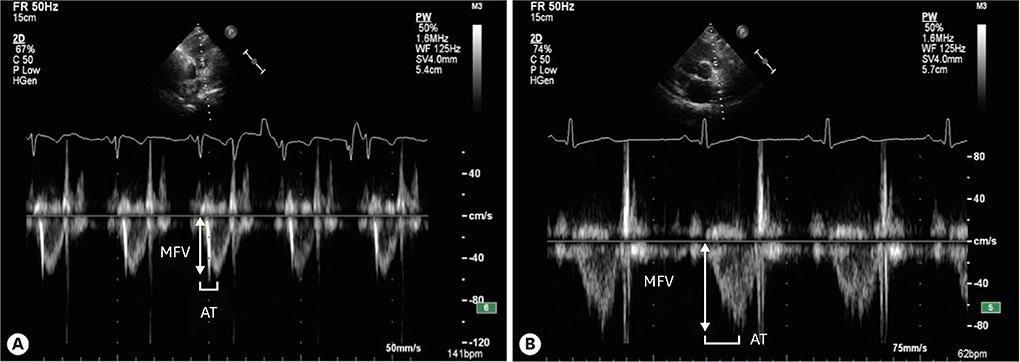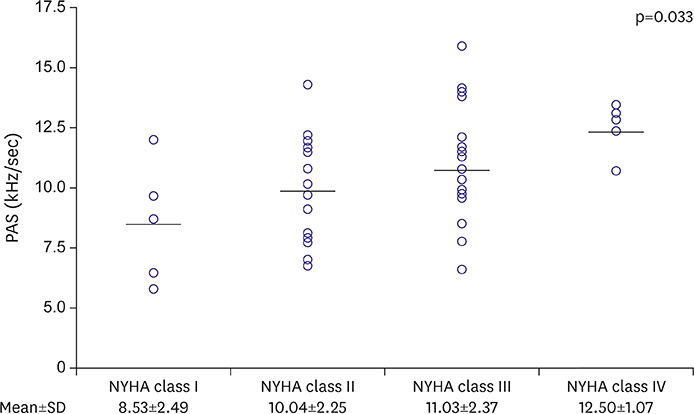Korean Circ J.
2017 Nov;47(6):929-938. 10.4070/kcj.2017.0081.
Relationship between Pulmonary Artery Stiffness and Functional Capacity in Patients with Heart Failure with Reduced Ejection Fraction
- Affiliations
-
- 1Department of Cardiology, Gulhane Training and Research Hospital, Ankara, Turkey. dr_erkanyildirim@yahoo.com.tr
- 2Department of Cardiology, Memorial Sisli Hospital, Istanbul, Turkey.
- 3Department of Cardiology, Corlu State Hospital, Tekirdag, Turkey.
- 4Department of Thoracic Medicine, Gulhane Training and Research Hospital, Ankara, Turkey.
- KMID: 2396486
- DOI: http://doi.org/10.4070/kcj.2017.0081
Abstract
- BACKGROUND AND OBJECTIVES
Functional capacity varies significantly among patients with heart failure with reduced ejection fraction (HFrEF), and it remains unclear why functional capacity is severely compromised in some patients with HFrEF while it is preserved in others. In this study, we aimed to evaluate the role of pulmonary artery stiffness (PAS) in the functional status of patients with HFrEF.
METHODS
A total of 46 heart failure (HF) patients without overt pulmonary hypertension or right HF and 52 controls were enrolled in the study. PAS was assessed on parasternal short-axis view using pulsed-wave Doppler recording of pulmonary flow one centimeter distal to the pulmonic valve annulus at a speed of 100 mm/sec. PAS was calculated according to the following formula: the ratio of maximum flow velocity shift of pulmonary flow to pulmonary acceleration time.
RESULTS
PAS was significantly increased in the HFrEF group compared to the control group (10.53±2.40 vs. 7.41±1.32, p < 0.001). In sub-group analysis of patients with HFrEF, PAS was significantly associated with the functional class of the patients. HFrEF patients with poor New York Heart Association (NYHA) functional capacity had higher PAS compared those with good functional capacity. In multivariate regression analysis, NYHA class was independently correlated with PAS.
CONCLUSION
PAS is associated with functional status and should be taken into consideration as an underlying pathophysiological mechanism of dyspnea in patients with HFrEF.
MeSH Terms
Figure
Reference
-
1. Lloyd-Jones D, Adams RJ, Brown TM, et al. Heart disease and stroke statistics--2010 update: a report from the American Heart Association. Circulation. 2010; 121:e46–e215.2. Ghio S, Gavazzi A, Campana C, et al. Independent and additive prognostic value of right ventricular systolic function and pulmonary artery pressure in patients with chronic heart failure. J Am Coll Cardiol. 2001; 37:183–188.3. Franciosa JA, Park M, Levine TB. Lack of correlation between exercise capacity and indexes of resting left ventricular performance in heart failure. Am J Cardiol. 1981; 47:33–39.4. Marantz PR, Tobin JN, Wassertheil-Smoller S, et al. The relationship between left ventricular systolic function and congestive heart failure diagnosed by clinical criteria. Circulation. 1988; 77:607–612.5. Piña IL, Apstein CS, Balady GJ, et al. Exercise and heart failure: a statement from the American Heart Association Committee on exercise, rehabilitation, and prevention. Circulation. 2003; 107:1210–1225.6. Kjaergaard J, Akkan D, Iversen KK, et al. Prognostic importance of pulmonary hypertension in patients with heart failure. Am J Cardiol. 2007; 99:1146–1150.7. Delgado JF, Conde E, Sánchez V, et al. Pulmonary vascular remodeling in pulmonary hypertension due to chronic heart failure. Eur J Heart Fail. 2005; 7:1011–1016.8. Görgülü S, Eren M, Yildirim A, et al. A new echocardiographic approach in assessing pulmonary vascular bed in patients with congenital heart disease: pulmonary artery stiffness. Anadolu Kardiyol Derg. 2003; 3:92–97.9. Mahfouz RA. Impact of pulmonary artery stiffness on right ventricular function and tricuspid regurgitation after successful percutaneous balloon mitral valvuloplasty: the importance of early intervention. Echocardiography. 2012; 29:1157–1163.10. Gorgulu S, Eren M, Uslu N, Ozer O, Nurkalem Z. The determinants of right ventricular function in patients with atrial septal defect. Int J Cardiol. 2006; 111:127–130.11. Kang KW, Chang HJ, Kim YJ, et al. Cardiac magnetic resonance imaging-derived pulmonary artery distensibility index correlates with pulmonary artery stiffness and predicts functional capacity in patients with pulmonary arterial hypertension. Circ J. 2011; 75:2244–2251.12. Lang RM, Badano LP, Mor-Avi V, et al. Recommendations for cardiac chamber quantification by echocardiography in adults: an update from the American Society of Echocardiography and the European Association of Cardiovascular Imaging. J Am Soc Echocardiogr. 2015; 28:1–39.e14.13. Jeffery TK, Wanstall JC. Pulmonary vascular remodeling: a target for therapeutic intervention in pulmonary hypertension. Pharmacol Ther. 2001; 92:1–20.14. Jardim C, Rochitte CE, Humbert M, et al. Pulmonary artery distensibility in pulmonary arterial hypertension: an MRI pilot study. Eur Respir J. 2007; 29:476–481.15. Duman D, Masatlioğlu S, Demirtunç R, Karadağ B. Increased pulmonary artery stiffness and its relation to right ventricular function in patients with systemic lupus erythematosus. Turk Kardiyol Dern Ars. 2008; 36:82–89.16. Celik M, Yuksel UC, Yalcinkaya E, et al. Elasticity properties of pulmonary artery in patients with bicuspid aortic valve. Echocardiography. 2014; 31:759–764.17. Gan CT, Lankhaar JW, Westerhof N, et al. Noninvasively assessed pulmonary artery stiffness predicts mortality in pulmonary arterial hypertension. Chest. 2007; 132:1906–1912.18. Mahapatra S, Nishimura RA, Sorajja P, Cha S, McGoon MD. Relationship of pulmonary arterial capacitance and mortality in idiopathic pulmonary arterial hypertension. J Am Coll Cardiol. 2006; 47:799–803.19. Weir-McCall JR, Struthers AD, Lipworth BJ, Houston JG. The role of pulmonary arterial stiffness in COPD. Respir Med. 2015; 109:1381–1390.20. Baykan AO, Gür M, Acele A, et al. Both systemic and pulmonary artery stiffness predict ventricular functional recovery after successful percutaneous closure of atrial septal defects in adults. Congenit Heart Dis. 2016; 11:144–154.21. Altıparmak IH, Erkuş ME, Polat M, et al. Relation of elastic properties of pulmonary artery with left ventricular abnormalities and aortic stiffness in patients with moderate to severe obstructive sleep apnea: a cross-sectional echocardiographic study. Turk Kardiyol Dern Ars. 2016; 44:289–299.22. Butler J, Chomsky DB, Wilson JR. Pulmonary hypertension and exercise intolerance in patients with heart failure. J Am Coll Cardiol. 1999; 34:1802–1806.23. Lam CS, Roger VL, Rodeheffer RJ, Borlaug BA, Enders FT, Redfield MM. Pulmonary hypertension in heart failure with preserved ejection fraction: a community-based study. J Am Coll Cardiol. 2009; 53:1119–1126.24. Sutendra G, Michelakis ED. Pulmonary arterial hypertension: challenges in translational research and a vision for change. Sci Transl Med. 2013; 5:208sr5.25. Vonk-Noordegraaf A, Haddad F, Chin KM, et al. Right heart adaptation to pulmonary arterial hypertension: physiology and pathobiology. J Am Coll Cardiol. 2013; 62:D22–D33.26. Saouti N, Westerhof N, Postmus PE, Vonk-Noordegraaf A. The arterial load in pulmonary hypertension. Eur Respir Rev. 2010; 19:197–203.27. Sanz J, García-Alvarez A, Fernández-Friera L, et al. Right ventriculo-arterial coupling in pulmonary hypertension: a magnetic resonance study. Heart. 2012; 98:238–243.28. Champion HC, Michelakis ED, Hassoun PM. Comprehensive invasive and noninvasive approach to the right ventricle-pulmonary circulation unit: state of the art and clinical and research implications. Circulation. 2009; 120:992–1007.
- Full Text Links
- Actions
-
Cited
- CITED
-
- Close
- Share
- Similar articles
-
- Prognostic Implications of Changes in Left Ventricular Ejection Fraction and Pulmonary Hypertension in Patients with Heart Failure with Reduced Ejection Fraction
- Optimal Management of Heart Failure with Preserve Ejection Fraction
- Total intravenous anesthesia using remimazolam for patients with heart failure with reduced ejection fraction: a case series
- Arterial-Cardiac Interaction: The Concept and Implications
- Simple and Practical Way of Assessing Diastolic Function: Diastolic Heart Failure Revisited



